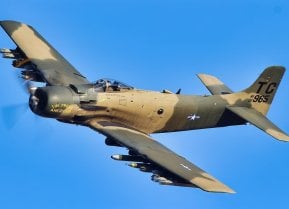The SR-71 Blackbird Once Hit Mach 3.5 and Made History
The SR-71 earned its reputation for incomparable speed. While no aircraft could catch it, neither could missiles.
The Lockheed SR-71 Blackbird was a fast plane. How fast? According to NASA, "Developed for the USAF as reconnaissance aircraft more than 30 years ago, SR-71s are still the world's fastest and highest-flying production aircraft. The aircraft can fly more than 2200 mph (Mach 3+ or more than three times the speed of sound) and at altitudes of over 85,000 feet."
It is also true that no interceptor ever really had a chance of catching the Blackbird in flight.
SR-71: Those Records
In fact, during the aircraft’s nearly 25 years in service, the Blackbird set numerous speed records, and on July 28, 1976, a Blackbird reached an impressive 2,193.167 miles per hour. Flying at roughly 36.55 miles per minute, or 3,216.4 feet per second, it was faster than a bullet fired from the World War II-era M1 Garand rifle, which had a muzzle velocity of 2,800 feet per second.
The SR-71 earned its reputation for incomparable speed. While no aircraft could catch it, neither could missiles. A dozen Blackbirds were lost to accidents during its service history, but not a single aircraft was shot down by an enemy. It reportedly evaded some 4,000 missiles fired its way.
SR-71 at Mach 3.5
The SR-71's official speed may have officially been Mach 3.2, but as TheAviationGeekClub reported it could fly even fast. Citing details from Blackbird pilot Brian Shul, during a flight over Libya in 1986, the high-flying reconnaissance aircraft was pushed to the extreme and perhaps a bit beyond. In addition, because the Blackbird surveillance missions are planned to the second with regard to speed, altitude, and fuel load, a speed excursion above Mach 3.2 was a pilot safety decision completely outside of pre-flight planning.
In his book Sled Driver, Shul also wrote that on the mission the aircraft was pushed to Mach 3.5, "The plane was flying a mile every 1.6 seconds, well above our Mach 3.2 limit. It was the fastest we would ever fly."
A-12 Was Even Faster
Despite the high-speed capabilities of the SR-71, another member of the family could go even faster. It was the A-12 Oxcart, which was developed in the early 1960s at the Lockheed Skunk Works, based on designs by Clarence "Kelly" Johnson, for use by the United States Central Intelligence Agency (CIA). In October 1962, the Air Force had also ordered three interceptor variants to replace the canceled F-108A Rapier. The modified A-12, first designated the AF-12 and then the YF-12A, was designed and built under a project codenamed KEDLOCK.

As part of Operation Black Shield, the Oxcart flew dozens of reconnaissance sorties in the latter stages of the Vietnam War. It was well suited to the missions, as it could perform sensitive intelligence-gathering flights while traveling at speeds over 2,260 miles per hour, or three times the speed of sound (Mach 3). However, in one flight, for "a very brief 15 seconds," the aircraft hit a speed of Mach 3.56 – just under 2,400 mph.
The aircraft's speed has been described as faster than the earth's rotation.
Expert Biography
Peter Suciu is a Michigan-based writer who has contributed to more than four dozen magazines, newspapers, and websites with over 3,000 published pieces over a twenty-year career in journalism. He regularly writes about military hardware, firearms history, cybersecurity, and international affairs. Peter is also a Contributing Writer for Forbes. You can follow him on Twitter: @PeterSuciu.
All images are Creative Commons.


